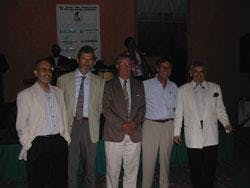Sustainable water supply highlighted at IDA World Congress
By Roberto Borsani
The spectacular Caribbean destination of Paradise Island hosted the 2003 International Desalination Association (IDA) World Congress on Desalination and Water Reuse, along with the 12th Annual Conference of the Caribbean Water and Wastewater Association from 28 September to 3 October.
Significant drops in water production costs have made desalination an affordable water supply alternative, so the concurrent events held at the Atlantis Resort, focused on solutions to the endemic problem of water shortage not only in the Caribbean, but also in many global regions.
In the opening ceremony, Prime Minister Perry Christie of the Bahamas, highlighted the complexity of water supply problems for the country, which includes 700 small and large islands. Most urgent, he explained, is the problem of supplying water to all people and farmers who benefit from a warm climate for crop production with close proximity to the Florida market - but not without water for agriculture.
More than 600 participants attended the IDA Conference, which started with a comprehensive presentation on the Caribbean's largest seawater desalination plant in Trinidad and Tobago, built by Desalcott, a joint venture between Ionics and local Trinidadian partner, Hafeez Karamath Engineering Services Limited. This project provides a good example on the integration of desalinated water in a conventional water supply network. Desalinated water from the Trinidad plant accounts for 10% of overall water consumption on the island and costs about US$ 0.70 per m3.
From Monday through Thursday, conference participants attended technical sessions on the following topics:
• research, development and operational results on major desalination technologies, such as multi-stage flash (MSF), multiple-effect ME) and reverse osmosis (RO);
• energy considerations and integration of desalination with thermal power plant;
• pretreatment, scaling and corrosion problems and;
• water management, planning and water cost.
Several desalination issues emerged often during the week-long event. First, the issue of integration between different technologies of seawater desalination crossed over through several sessions. The three major technologies, MSF, ME and RO, have advantages and disadvantages that can be, respectively, enhanced and depleted if a combination of two or more technologies are used in a so-called hybrid desalination plant.
Second, problems related to energy consumption, is of great concern. Obviously, all desalination technologies are not ideal and energy consumption is high, accounting for some 20% to 30% of production costs. RO consumes the lowest energy, but other factors can increase total water production costs. The overall installation and local situation must also be considered; some experts contend that the optimum configuration is not always the one which has the lowest specific energy consumption. Instead a thermo-economic evaluation could be more helpful in identifying the best power and water combination.
Third, desalinated water costs and its affordability for countries with less funds available for major infrastructure projects is an issue that lead to more discussions of non-conventional technologies. Typically, countries able to afford large-scale desalination plants benefit from "economy of scale." Large-scale plants can produce water for as low as US$ 0.50 per m3, but for countries least able to afford much-needed water supplies, the only way to lower the cost of desalinated water is to develop less expensive, unconventional technologies. This alternative cannot be used for large production, but it could more easily be used in spot locations with low investment and good results. For example, the use of renewable resources as a direct method of desalination or as a direct source of power coupled to a conventional desalination plant, could make the technology more affordable.
The new IDA President Mr. Abdulhamid A. Al-Mansour, director general of the Saline Water Conversion Corporation of Saudi Arabia, was voted in during the World Congress, replacing the 2001-2003 term president, William Andrews, managing director of DesalCo Limited.
The next IDA World Congress will be held in Singapore in October 2005.
The IDA presented four Best Paper Awards to:• "A new design approach to reduce water costs in MSF desalination" by Dr. Emilio Ghiazza and Patrizio Peloffo of Fisia Italimpianti, Italy.
• "Meeting the challenge of large RO plant in the Middle East," by Ian Keith Callister, Henry M. Hogg and Dr. Corrado Sommariva of Mott MacDonald, UK.
• "Boron removal in seawater desalination," by Markus Busch, Jean-Pierre De Witte, Steven Jons, William Mickols and Jorge Redondo of DOW, USA.
• Poster "Why a SWRO in Taweelah? Pilot plant results demonstrating feasibility and performance of SWRO on Gulf water," by Jean-Marie Rovel of Ondeo, France.
Roberto Borsani is the manager of the desalination department in Fisia Italimpianti, based in Genova, Italy, and served on the IDA Board of Directors for the past ten years.

